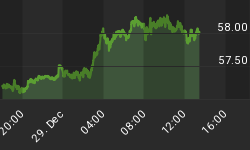Intel Corp (INTC) is trading at one of the lowest price earnings ratios in its history. Apparently the market must feel that PCs are dead, and therefore, so is Intel. However, we believe most of the weakness in PCs can be attributed to buyers holding back as they await the release of Windows8. Consequently, we believe that Intel represents an extremely attractive opportunity to buy this technology bellwether at a bargain valuation while simultaneously earning a generous and growing dividend yield.
Earnings Determine Market Price: The following earnings and price correlated FAST Graphs™ clearly illustrates the importance of earnings. The Earnings Growth Rate Line or True Worth™ Line (orange line with white triangles) is correlated with the historical stock price line. On graph after graph the lines will move in tandem. If the stock price strays away from the earnings line (over or under), inevitably it will come back to earnings.
Earnings & Price Correlated Fundamentals-at-a-Glance
A quick glance at the historical earnings and price correlated FAST Graphs™ on Intel Corp paints a vivid picture of significant undervaluation based upon the historical earnings growth rate of 15.4% and a current PE of 9.9. Clearly, Intel's earnings growth rate has accelerated since the great recession of 2008. However, we believe the expected weakness for 2012 is as we previously stated, mostly attributed to delayed purchases pending Windows 8.
Currently, analysts are forecasting the earnings growth to average about 10% a year starting in 2014 and beyond. However, concerns for 2013 are still low. Nevertheless, even if 2013 generates the muted growth rate expected, we would argue that Intel with a 4% dividend yield is worth at least 15 times earnings (the orange line on the graphic below).
Intel Corp: Historical Earnings, Price, Dividends and Normal PE Since 2009
For a more comprehensive look at a bullish case for the long-term opportunity in front on Intel, we direct you to the following excellent article entitled Intel: There's Certainly A Bull Case by Ashraf Eassa.
Moreover, in order to conduct your own research and get a clearer perspective on Intel's valuation, click on the picture below that links you to a fully functioning sample F.A.S.T. Graphs™ on Intel and research this high-quality dividend growth stock deeper and faster.

Performance Table Intel Corp
The associated performance results with the earnings and price correlated graph, validates the principles regarding the two components of total return; capital appreciation and dividend income. Dividends are included in the total return calculation and are assumed paid, but not reinvested.
When presented separately like this, the additional rate of return a dividend paying stock produces for shareholders becomes undeniably evident. In addition to the 12.4% capital appreciation (green circle), long-term shareholders of Intel Corp , assuming an initial investment of $1,000, would have received an additional $178.54 in dividends that increased their total return from 12.4% to 15.7% per annum versus 13.9% in the S&P 500.

The following graph plots the historical PE ratio (the dark blue line) in conjunction with 10-year Treasury note interest. Notice that the current price earnings ratio on this quality company is as low as it has been since 2009.

A further indication of valuation can be seen by examining a company's current price to sales ratio relative to its historical price to sales ratio. The current price to sales ratio for Intel Corp is 2.09 which is historically low.

Looking to the Future
Extensive research has provided a preponderance of conclusive evidence that future long-term returns are a function of two critical determinants:
-
The rate of change (growth rate) of the company's earnings
-
The price or valuation you pay to buy those earnings
Forecasting future earnings growth, bought at sound valuations, is the key to safe, sound, and profitable performance.
The Estimated Earnings and Return Calculator Tool is a simple yet powerful resource that empowers the user to calculate and run various investing scenarios that generate precise rate of return potentialities. Thinking the investment through to its logical conclusion is an important component towards making sound and prudent commonsense investing decisions.
The consensus of 23 leading analysts reporting to Capital IQ forecast Intel Corp's long-term earnings growth at 10% (orange circle). Intel Corp has low long-term debt at 13% of capital (red circle). Intel Corp is currently trading at a P/E of 9.9, which is below the value corridor (defined by the five orange lines) of a maximum P/E of 18 (orange arrow). If the earnings materialize as forecast, Intel Corp's True Worth™ valuation would be $50.73 at the end of 2018 (brown circle on EYE Chart), which would be a 19.4% annual rate of return from the current price (yellow highlighting).

Earnings Yield Estimates
Discounted Future Cash Flows: All companies derive their value from the future cash flows (earnings) they are capable of generating for their stakeholders over time. Therefore, because Earnings Determine Market Price in the long run, we expect the future earnings of a company to justify the price we pay.
Since all investments potentially compete with all other investments, it is useful to compare investing in any prospective company to that of a comparable investment in low risk Treasury bonds. Comparing an investment in Intel Corp to an equal investment in 10 year Treasury bonds, illustrates that Intel Corp's expected earnings would be 9.2 (purple circle) times that of the 10 Year T-Bond Interest. (See EYE chart below). This is the essence of the importance of proper valuation as a critical investing component.

Summary & Conclusions
This report presented essential "fundamentals at a glance" illustrating the past and present valuation based on earnings achievements as reported. Future forecasts for earnings growth are based on the consensus of leading analysts. Although, with just a quick glance you can know a lot about the company, it's imperative that the reader conducts their own due diligence in order to validate whether the consensus estimates seem reasonable or not.
Disclosure: Long INTC at the time of writing.
















